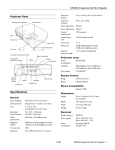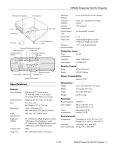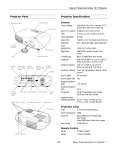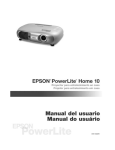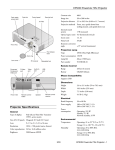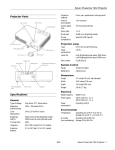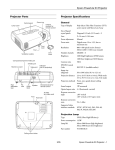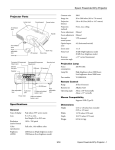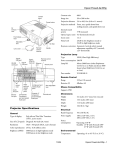Download Epson PowerLite S1 Product information guide
Transcript
PRODUCT INFORMATION GUIDE EPSON UPDATE 5/19/02 This package provides a new multimedia projector product section to be added to the EPSON ® Product Information Guide. The table of contents of this section is listed below. EPSON PowerLite® S1 TABLE OF CONTENTS Projector Parts .............................................................................................. EPSON PowerLite S1 - 1 Projector Specifications ................................................................................ EPSON PowerLite S1 - 1 Positioning the Projector .............................................................................. EPSON PowerLite S1 - 3 Turning the Projector On and Off ............................................................... EPSON PowerLite S1 - 4 Troubleshooting ........................................................................................... EPSON PowerLite S1 - 5 Switching Between Picture Sources............................................................... EPSON PowerLite S1 - 6 Adjusting the Image ..................................................................................... EPSON PowerLite S1 - 6 Selecting the Color Mode ............................................................................. EPSON PowerLite S1 - 8 Using the Automatic Setup........................................................................... EPSON PowerLite S1 - 8 Selecting the Aspect Ratio ............................................................................ EPSON PowerLite S1 - 8 Turning Off the Picture and Sound ............................................................. EPSON PowerLite S1 - 8 Freezing the Action....................................................................................... EPSON PowerLite S1 - 8 Projector Status Lights.................................................................................. EPSON PowerLite S1 - 9 Using the Remote Control ........................................................................... EPSON PowerLite S1 - 9 Using the Menus .......................................................................................... EPSON PowerLite S1 - 10 Using the Presentation Remote .................................................................... EPSON PowerLite S1 - 10 Replacing Remote Control Batteries............................................................. EPSON PowerLite S1 - 11 Cleaning the Lens......................................................................................... EPSON PowerLite S1 - 11 Cleaning the Projector Case.......................................................................... EPSON PowerLite S1 - 11 Cleaning the Air Filter.................................................................................. EPSON PowerLite S1 - 11 Replacing the Air Filter................................................................................. EPSON PowerLite S1 - 12 Replacing the Lamp...................................................................................... EPSON PowerLite S1 - 12 Optional Accessories..................................................................................... EPSON PowerLite S1 - 14 Related Documentation................................................................................ EPSON PowerLite S1 - 14 5/03 EPSON PowerLite S1 Projector Projector Parts Projector Specifications Control panel Focus ring General Speaker Type of display Ventilation outlet Infrared receiver for remote control Foot button Handle Lens cover Foot Computer/Component Video port S-Video port Size of liquid crystal panels Diagonal: 0.5 inches (12.5 mm) × 3 Lens F=1.4 mm, f=16.6 mm Focus adjustment Manual Zoom ratio Digital 1.0 to 1.2, lens at maximum size Resolution 800 × 600 pixels (native format) Number of pixels 480,000 × 3 Brightness 1200 ANSI lumens Contrast ratio 400:1 EPSON Control Code ESC/VP 21 (available online) Image size (diagonal) 30 to 300 inches (0.9 to 11.3 m) Projection distance Video port RS-232C port Monitor out port L – Audio – R Audio input Monitor Out Keystone correction angle ±15° vertical Remote control holder Air filter (air intake vent) Keystone correction ratio 9.6:1 AC inlet Security lock Ceiling mount holes 1W monaural Optical aspect ratio 4:3 (horizontal : vertical), adjustable to 16:9 for HDTV, NTSC, PAL, and SECAM images Control (RS-232C) Infrared receiver for remote control 2.9 to 30 ft (0.9 to 9.0 m), Wide mode 3.5 to 37 ft (1.1 to 11.3 m), Tele mode Projection methods Front, rear, upside-down (ceiling mount) Sound output Computer / S-Video Video Component video Poly-silicon Thin Film Transistor (TFT) active matrix with Micro Lens Array Supported video interface standards Rubber foot Lamp cover NTSC, NTSC4.43, PAL, PAL-M, PAL-N, PAL60, SECAM Projection Lamp Type UHE (Ultra High Efficiency) Power consumption 132W Lamp life About 2000 hours Part number V13H010125 Remote Controls Handle 5/03 Range 20 feet (6 meters) Battery Lithium (CR2025) EPSON PowerLite S1 Projector - 1 EPSON PowerLite S1 Projector Dimensions Height Computer 4.2 inches (106 mm) Resolution (dots) Resized display resolution (dots) Width 14.6 inches (370 mm) Signal Refresh Rate (Hz) Depth 10.4 inches (265 mm) VGA 60 640 × 480 800 × 600 Weight approximately 7 lb (3.2 kg) VGAEGA 70 640 × 350 800 × 438 VESA 72 / 75 / 85, iMac* 640 × 480 800 × 600 SVGA 56 / 60 / 72 / 75 / 85, iMac* 800 × 600 800 × 600 XGA 43i / 60 / 70 / 75 / 85, iMac* 1024 × 768 800 × 600 Electrical Rated frequency 50/60 Hz Power supply 100 to 120 V model: 100 to 120 VAC, 2.7 A 200 to 240 V model: 200 to 240 VAC, 1.3 A MAC13” 67 640 × 480 800 × 600 Power consumption Operating: 180W Standby: 5W MAC16” 75 832 × 624 800 × 600 MAC19” 75 1024 × 768 800 × 600 Environmental MAC21” 75 1152 × 870 794 × 600 SDTV (480i) 60 640 × 480 800 × 600 SDTV (480p) 60 640 × 480 800 × 600 HDTV (720p) 60 1280 × 720 800 × 450 HDTV (1080i) 60 1920 × 1080 800 × 450 Temperature (non-condensing) Operating: 41 to 95° F (5 to 35° C), Storage: 14 to 140° F (–10 to 60° C) Safety United States FCC Part 15J Class B UL1950 Rev. 3 * Connection is not possible if the equipment does not have a VGA output port. Canada DOC SOR/88-475 CSA C22.2 No. 950-95 (cUL) Component Video CE Marking Directive 73/23/EEC EN 60950 Directive 89/336/EEC EN 55022 Class B EN 55024 Compatible Video Formats The projector supports the video formats listed in the following tables. To project computer images, the computer’s video card must be set at a refresh rate that’s compatible with the projector. See your computer documentation for details. Signal Refresh Rate (Hz) SDTV(480i)(D1) Resolutions (dots) Aspect ratio 4:3 Aspect ratio 16:9 60 800 × 600 800 × 450 SDTV(625i) 50 800 × 600 800 × 450 SDTV(525p)(D2) 60 800 × 600 800 × 450 HDTV(720p) 16:9 (D4) 60 800 × 600 800 × 450 HDTV(1080i) 16:9 (D3) 60 800 × 600 800 × 450 Composite Video/S-Video Resolutions (dots) Signal Aspect ratio 4:3 Aspect ratio 16:9 TV(NTSC) 800 × 600 800 × 450 TV(PAL, SECAM) 800 × 600 800 × 450 It may be possible to project signals which are not listed above. However, not all functions may be supported with such signals. 2 - EPSON PowerLite S1 Projector 5/03 EPSON PowerLite S1 Projector Image Size and Projection Distance Positioning the Projector The distance between the projector and the screen determines the basic size of the projected image, as shown below. Because other adjustments—such as those made with the Aspect and Keystone buttons—also affect the size of the image, the numbers shown in the illustration should be considered for general guidelines, not exact measurements. Follow these guidelines to get the best results when projecting: ❏ Place the projector on a sturdy, level surface, between 3 and 37 feet from the screen. ❏ Make sure there is plenty of space for ventilation around and under the projector. ❏ Make sure the projector is within 10 feet of a grounded electrical outlet or extension cord and within 5 feet of the image source. ❏ Face the projector squarely toward the screen. The projector supports 4 viewing setups, as shown below. If it is installed in a rear or overhead position, you need to select the correct projection option from the Setting menu after you turn it on. Table Convenient for temporary front projection. Choose Front from the menu. Use the formulas given below to either find out how large your image will be when you know the distance from the projector to the screen, or to find out how far from the screen to place the projector when you want an image of a certain size. Since the size of the image can be changed by rotating the zoom ring, formulas are given for both the minimum and maximum sizes. Ceiling Professional installation recommended. Choose Front/Ceiling from the menu. To determine the diagonal size of an image when you know the projection distance: Maximum diagonal size = (0.8488 × projection distance) + 0.90242 Minimum diagonal size = ((0.8488 × projection distance) + 0.90242) × 0.8071 To determine the projection distance when you know the diagonal size of the screen image: Rear For permanent installation behind a translucent screen. Choose Rear from the menu. Maximum projection distance = (diagonal size × 2.9924) 2.7004/2.54 Minimum projection distance = ((diagonal size × 2.9924) 2.7004/2.54)/0.8071 Rear/Ceiling Professional installation behind a translucent screen recommended. Choose Rear/Ceiling from the menu. If the projector is tilted in the front or the back, you may need to adjust the image shape. See page 7. 5/03 EPSON PowerLite S1 Projector - 3 EPSON PowerLite S1 Projector 5. Press the P Power button on the remote control or the top of the projector to turn on the projector. Turning the Projector On and Off Once you’ve connected the projector to your computer or other equipment follow these instructions to turn it on and display an image: Power button 1. Make sure the power is turned off for the projector and any sources connected to it. 2. Remove the lens cover. You hear a beep, the P Power light flashes green as the projector warms up, and the projection lamp comes on in about 6 seconds. Note: You may see a blue screen with the No Signal message displayed. This is normal. 3. Connect the power cord to the projector and plug the other end into a grounded electrical outlet. 6. If you are using a computer, turn it on now. 7. Start your video or presentation. If you have connected more than one video or computer source, you may need to press the Computer or S-Video/Video button on the remote control or the Source button on the projector to select the one you want to watch. (See “Switching Between Picture Sources” on page 6 for more information.) If the image is upside-down or reversed, you need to turn on the Rear, Ceiling, or Rear/Ceiling option in the Setting menu. The P Power light on the projector turns orange, indicating that the projector is receiving power, but is not yet turned on. If a projected image fails to appear, see the following section, “Troubleshooting.” Once you see your image, see page 6 for instructions on focusing and making other image adjustments. Orange Turning Off the Projector When you’re ready to shut down the projector, follow these steps: 1. Turn off any video or computer sources connected to the projector first. Note: The projector will not respond to any buttons on the control panel or remote control while the power light is flashing orange. 2. Press the P Power button on the projector or remote control to turn off the projector. 4. If you are connecting to a device other than a computer, turn on your equipment. (If you are connecting to a computer, don’t turn it on yet.) 4 - EPSON PowerLite S1 Projector You see a confirmation message: If you don’t want to turn it off, press any button or ignore the message. (It disappears in about 7 seconds.) 5/03 EPSON PowerLite S1 Projector If you’re using a Macintosh® PowerBook® with Mac OS® X: 3. Press the P Power button again. The lamp is turned off and the P Power light flashes orange as the projector cools down. When the projector has cooled, the P Power light stays orange and the exhaust fan shuts off. 1. Select System Preferences from the Apple® menu and click Displays. Note: If you want to turn the projector on again, wait until the orange light stops flashing. Then press the P Power button. 2. Click Detect Displays. 4. Unplug the power cord from the electrical outlet. Caution: Do not disconnect the power cord while the power light is flashing orange because it may cause problems with the projector. 5. Replace the lens cover. Click here Troubleshooting 3. To display the entire desktop on both your projector screen and LCD screen, click the Arrangement or Arrange tab. (If you don’t see this tab, make sure it is not hidden by another window on your screen.) If you see a blank screen If you see a blank screen or the No Signal message, check the following: 4. Click Mirror Displays in the lower corner of the screen. One of the monitor icons automatically moves on top of the other. ❏ Make sure the P power light on the projector is green and not flashing and the lens cover is off. ❏ Try turning off the notebook and restarting it. ❏ If you’ve connected more than one computer and/or video source, you may need to press the Source button on top of the projector to select your video source. (Allow a few seconds for the projector to sync up after pressing it.) ❏ If you’re using Windows®, hold down the Fn key and press the function key that lets you display on an external monitor. It may have an icon such as , or it may be labelled CRT/LCD. (Allow a few seconds for the projector to sync up after pressing it.) Click here If the projector and notebook don’t display the same image If you’re using a Macintosh PowerBook with Mac OS 9.x or earlier: If you’re using a Windows notebook: 1. From the Apple menu, select Control Panels, then click Monitors and Sound. ❏ On most systems, the or CRT/LCD key lets you toggle between the LCD screen and the projector, or display on both at the same time. ❏ You might need to use the Display utility in the Control Panel to enable both the LCD screen and external monitor port. Check your notebook’s manual or online help for details. ❏ If you have dual monitor support, you may need to uncheck the option to extend your Windows desktop in the Display Properties. 5/03 EPSON PowerLite S1 Projector - 5 EPSON PowerLite S1 Projector 2. Click the Arrange icon, and then drag one monitor icon on top of the other. Adjusting the Image Click here The following sections describe how to adjust the image once it is displayed. Adjusting the Height of the Image The projector should be as perpendicular to the screen as possible. If the image is too low, you can raise it by extending the projector’s front feet. Drag one monitor icon on top of the other 1. Stand behind the projector. Press the foot release buttons and lift the front of the projector. This unlocks the feet. Foot release button Note: If the Arrange option isn’t available, you may need to select one of the Simulscan resolution settings. Click the Monitor icon and then select a Simulscan resolution from the ones in the Resolution box. (Allow a few seconds for the projector to sync up after making the selection.) Switching Between Picture Sources 2. Once the image is positioned where you want it, release the buttons to lock the feet in place. You can connect the projector to multiple video sources simultaneously. Then you use the buttons on the projector or remote control to switch between them: 3. If you need to straighten the image, rotate the feet to raise or lower the sides. ❏ Press the Source button on the projector to switch between computer or component video, S-video, and composite video sources. ❏ On the remote control, press the Computer button to select a computer or component video source. Press the Video/S-Video button to select a composite or S-Video source. After you select a source, the screen goes dark for a moment before the image appears. The name of the source appears briefly on the screen. If the image is no longer square after raising it, see page 7. Focusing the Image Rotate the focus ring to sharpen the image. Note: If a computer image is still out of focus, you can increase the clarity by pressing the Auto button on the remote control. See page 8. 6 - EPSON PowerLite S1 Projector 5/03 EPSON PowerLite S1 Projector Adjusting the Image Size Adjusting the Image Shape You can adjust your image size using the zoom button on the projector, or zoom into a portion of the image using the E-Zoom button on the remote control. When the projector is raised in the front or back, the display distorts in the shape of a trapezoid. Using the Zoom Button To enlarge or reduce your image size in small increments, press the Wide button to enlarge the image or press the Tele button to reduce it. Note: You can correct only vertical distortion with this function. Horizontal distortion cannot be corrected. Note: You can always move the projector closer to or farther from the screen to adjust the image size. Press the [u] or [d] buttons to correct the distortion. Using the E-Zoom Button The image is enlarged or reduced. 1. Press the E-Zoom z button on the remote control. A target scope is displayed on the screen. 2. Press the [u][d][l][r] buttons to move the target scope to the center of the part you wish to enlarge/reduce. Note: Screen size changes when keystone correction is performed. If the images become uneven in appearance after keystone correction is performed, decrease the sharpness setting. target scope Images can be corrected without distortion when the projector is tilted to a maximum of ±15°. 3. Push E-Zoom z to enlarge the image. Push E-Zoom x to reduce the enlarged image. Adjusting the Image Quality You may need to adjust the projector’s Tracking and Sync settings on the Image menu if your computer image has any of these quality problems: ❏ Flashing or blurry image ❏ Vertical or horizontal stripes ❏ Only a portion of the image is displayed enlargement ratio See the User’s Guide for more information. ❏ E-Zoom z: Enlarges part of the image without changing the size of the projection area. Auto button on the remote control to optimize the tracking, sync, ❏ E-Zoom x: Reduces the part of the image that has been enlarged using the z button. and position settings. Turn off E-Zoom and A/VMute before using the Auto button. Note: You can also increase computer image clarity by pressing the ❏ You can scroll with the [u][d][l][r] buttons. Press Esc to cancel. 5/03 EPSON PowerLite S1 Projector - 7 EPSON PowerLite S1 Projector Selecting the Color Mode Selecting the Aspect Ratio There are five color modes available. Make a selection appropriate for the conditions in which you are projecting. The aspect ratio is the ratio between an image’s width and its height. Standard images have an aspect ratio of 4:3 and HDTV and DVD images have an aspect ratio of 16:9. If your video source is 16:9, you can change the aspect ratio to view the video in 16:9 wide-screen format. ❏ Dynamic Images are modulated and made crisper to emphasize brightness. ❏ Presentation Brightness is emphasized. For presentations in bright rooms. ❏ Theatre Best for watching movies in their natural tones. ❏ Living Room Press the Aspect button on the remote control to change the aspect ratio. Brightness is emphasized. Ideal for playing video games in bright rooms. ❏ sRGB Conforms to the sRGB color standard. If the connected source has an sRGB mode, set both the projector and the connected source to sRGB. The color mode changes each time you press the Color Mode button on the remote control. Turning Off the Picture and Sound Dynamic → Presentation → Theatre → Living Room → sRGB Press the A/V Mute button on the remote control to darken your screen and turn off the sound. When you’re ready to resume, press A/V Mute again. Default Value Note: You can also change the color mode through the Image menu. If you press the button while projecting from a video source, and you don’t pause the video, it continues to play even though you can’t see or hear it. When you press the A/V Mute button again to resume, the playback does not resume at the exact point you paused it. Using the Automatic Setup Note: You can make the blank screen blue, instead of black, whenever you press the A/V Mute button by selecting it as the background color in the Setting menu. ❏ Computer input: Presentation ❏ Other input: Dynamic If you are projecting from a computer, the projector automatically adjusts the input signals to produce the best image quality. Automatic setup adjusts the Tracking, Sync, and other image settings. Freezing the Action Press the Freeze button on the remote control to temporarily freeze the action on the screen. This freezes any moving images on the screen until you press the Freeze button again. However, if Auto Setup in the Image menu is set to OFF, you need to press the Auto button on the remote control while projecting from a computer to have the projector make the adjustments. Like the A/V Mute feature, if you are projecting a video, the video and audio continue while the projected image is paused, so when you press the Freeze button again to resume, the playback does not resume where you stopped it. Sometimes the signals may not be adjusted correctly, depending on the type of signals being output by the computer. In such cases, use the Image menu to adjust the tracking and sync settings manually. 8 - EPSON PowerLite S1 Projector 5/03 EPSON PowerLite S1 Projector Projector Status Lights Using the Remote Control If your projector isn’t working correctly, first turn it off, wait for it to cool, and unplug it. Then plug the power cord back in and turn on the projector. If this doesn’t solve the problem, check the lights on top of the projector. They alert you to problems with projector operations. The remote control uses a line-of-sight infrared signal. It lets you access the projector’s features from anywhere in the room— up to 20 feet away. (This distance may be shorter if the remote control batteries are low.) The projector may not respond to remote control commands in these conditions: ❏ You are too far away—not within 20 feet (6 meters)—or not within 30° to the left or right of the front or rear sensor or 15° above or below it Power light ❏ The battery is weak or not installed correctly Error light ❏ Ambient light is too bright ❏ A fluorescent light is shining into the infrared receiver Light Status Description and action off The projector is unplugged. If you want to turn it on, make sure the power cable is connected securely at both ends, then press the Power button to turn on the projector. orange The projector is in sleep (or standby) mode. You can unplug it to turn it off or press the Power button to turn it on. flashing green The projector is warming up. Warming up takes about 35 seconds (the EPSON logo appears after approximately 6 seconds). When warming up is complete, the indicator changes to steady green. green The projector is operating normally. flashing orange The projector lamp is off and the projector is cooling down. Wait until the light stops flashing. (The cool-down period lasts about 20 seconds.) Then, if you want to turn it off, unplug it. If you want to turn it on, press the Power button. (You can’t turn the projector on, and you should never unplug it, when the light is flashing orange.) red The projector is too hot and the lamp has turned off. Wait 5 minutes, then unplug it and make sure nothing is blocking the projector’s air filter. If it continues to overheat, clean the air filter; see page 11 for instructions. flashing red at 0.5second intervals The lamp cover is not closed securely or the lamp is broken or has burned out. Secure the lamp cover or replace the lamp; see page 12 for instructions. flashing orange The projector lamp has turned off automatically because the projector has overheated. Let it cool for a few minutes, then turn it back on. Make sure nothing is blocking the air filter. If it continues to overheat, clean the air filter; see page 11 for instructions. flashing red at 1-second intervals ❏ A strong light source (such as direct sunlight) shines into the infrared receiver ❏ Other equipment emitting infrared energy is present (such as a radiant room heater) E-Zoom x reduces the zoomed part of the image E-Zoom z zooms in on (enlarges) the selected area of the image Cycles through 5 color modes: Dynamic, Presentation, Theatre, Living Room, sRGB Selects computer or component video source Selects S-Video or Video source Changes the aspect ratio of images from 4:3 to 16:9 Cancels the current function or displays the previous menu or screen when using the projector menus Selects a highlighted menu option or displays the next screen or menu Automatically adjusts computer images to their optimum settings when Auto Setup has been turned off in the Video menu Displays or hides the projector menus Turns off the audio and video; press it again to resume There is an internal problem with the projector. Unplug it from the electrical outlet and contact EPSON for help. 5/03 Turns projector on or off Freezes the current video or computer image on the screen When a menu is displayed, the buttons select menu items and settings; when using the E-Zoom function, these buttons move the scope around the screen and scroll the image EPSON PowerLite S1 Projector - 9 EPSON PowerLite S1 Projector Using the Menus Using the Presentation Remote The on-screen menus let you adjust and customize the projector features from the remote control: Operate the presentation remote control by aiming it at the presentation remote receiver. ❏ Image controls the look and quality of the projected image (from a computer or video source). When using the Freeze or A/V Mute functions, aim the presentation remote control towards the infrared receiver on the projector. ❏ Setting adjusts features such as the keystone setting, blank screen color, sleep mode, and rear or ceiling projection. Press to scroll back and forth through pages when projecting a presentation ❏ Info provides information about the current projector and lamp settings. ❏ Reset restores the factory defaults to all the projector settings and lets you reset the lamp timer when you’ve replaced the projector’s lamp. Changing Menu Settings You use the Menu, e, and Esc buttons on the remote control To move the mouse pointer, move in any of the following directions: up, down, left, right, diagonally Acts as a left-click Double click: push twice Drag and drop: press and hold and move the mouse pointer to change menu settings. 1. Press the Menu button. The top configuration menu is displayed. Acts as a right-click 2. Press the u or d buttons to select the Top Menu item. 3. Press the e button. Sub Menu 1 is displayed. 4. Press the u or d buttons to select the Sub Menu 1 items, then press the e button. Temporarily turns off/on the audio and video 5. For Sub Menu 2, press the u or d buttons in the same way, then press the e button. 6. Settings can be changed in the follwing ways: Note: If the mouse button settings are reversed on the computer, the operation of the remote control buttons will also be reversed. ❏ Press the l or r buttons to change the setting values. ❏ Press the u or d buttons to select the menu item. Then press the e button. You can use the presentation remote control as a wireless mouse to control the mouse pointer on the computer screen.The presentation remote contains all the functions necessary for giving a presentation. Functions include: Page Up/Page Down, Left/Right mouse click, A/V mute, freeze, and mouse pointer. The current setting has a green dot by the name and the current menu selection is highlighted in orange. Press the e button to confirm the selection. ❏ Press the l or r buttons to select the value. Then, press the e button. ❏ Press the u d l r buttons to move the image display position. 7. Set other items in the same way. Press the Esc button to return to the previous item or menu, or select Return. 8. Press the Menu button to finish. Note: The mark is displayed after items which perform a setting or lead to a sub menu. 10 - EPSON PowerLite S1 Projector Keeps the current computer or video image on the screen Before using the presentation remote control, remove the insulation tape. 5/03 EPSON PowerLite S1 Projector Compatible computers Cleaning the Lens Windows: Windows 98/2000/Me/XP Macintosh: Mac OS 9.1 or later/OS X 10.1 or later Clean the lens whenever you notice dirt or dust on the surface. Note: The presentation remote receiver can only be connected to computers with a standard USB interface. ❏ To remove dust, use a canister of compressed air to spray the lens surface, or lightly wipe the lens surface with a soft, dry, lint-free cloth. Some computer settings may have to be changed for the mouse function to be used. See your computer’s documentation for details. ❏ To remove dirt or smears, use lens-cleaning paper. If necessary, moisten a soft cloth with an alcohol-based cleaner and gently wipe the lens surface. Caution: Do not rub the lens with harsh material or subject it to shocks, as it can be easily damaged. Replacing Remote Control Batteries When the battery in the remote control or presentation remote control runs out, follow the steps below to replace it. Each remote requires one CR2025 lithium battery. Cleaning the Projector Case 1. Remove the battery holder. Before you clean the projector case, turn off the projector and unplug the power cord. ❏ To remove dirt or dust, wipe the outside with a soft, dry, lint-free cloth. Press here and slide out battery holder ❏ To remove stubborn dirt or stains, clean the case using a soft cloth moistened with water and a neutral detergent. Dry it using a separate cloth. 2. Remove the old battery and insert the new one. Make sure the + side of the battery is facing up, as shown. Caution: Do not use alcohol, benzene, thinner, wax, or other chemicals. These can damage the case. New battery + Mark Cleaning the Air Filter Old battery If the air filter becomes clogged with dust, it can cause overheating and damage the projector. Follow these steps to clean the filter: 3. Slide the battery holder back into the remote control until it clicks into place. 1. Turn off the projector, let it cool down, and unplug the power cord. Caution: When replacing the battery, take the following precautions: ❑ Replace the battery as soon as it runs out. ❑ If the battery leaks, wipe away battery fluid with a soft cloth. If fluid gets on your hands, wash them immediately. ❑ Remove the battery if you will not be using the remote for a long period of time. ❑ Dispose of the used battery in accordance with your local regulations. 5/03 EPSON PowerLite S1 Projector - 11 EPSON PowerLite S1 Projector 4. Replace the air filter with a new one. Make sure there are no gaps between the air filter and the plastic grill. 2. Turn the projector upside-down and use a small vacuum cleaner designed for computers and other office equipment. If you don’t have one, use a dry, lint-free cloth. 5. Insert the air filter cover tabs, and then press down on the opposite side until it clicks into place. Note: If the air filter is difficult to clean or if it is broken, it should be replaced. See the next section for instructions. Spare lamps are provided with new air filters. When replacing the lamp, please replace the air filter at the same time. Replacing the Air Filter If you need to replace the air filter, you can obtain it in the following ways: Replacing the Lamp ❏ Purchase one from your dealer ❏ Call EPSON at (800) 873-7766 or visit the EPSON StoreSM at www.epsonstore.com (U. S. sales only). In Canada, please call (800) 463-7766 for dealer referral. The projection lamp typically lasts for about 2000 hours of use. It is time to replace the lamp when: Note: If you are also replacing the lamp, you can use the new air filter that comes with it. ❏ The error light on top of the projector is flashing red in 0.5-second intervals. ❏ The projected image gets darker or starts to deteriorate. ❏ The message LAMP REPLACE appears on the screen when the projector lamp comes on (after about 1900 hours of use). To maintain projector brightness and image quality, replace the lamp as soon as possible after you see the message. Follow these steps to replace the air filter: 1. Turn off the projector and wait for it to cool down. 2. Disconnect the power cord. Request replacement lamp part number V13H010125. 3. Turn the projector upside-down. Push in the tab on the air filter cover and lift up the air filter cover to remove it. Note: To view the number of hours your lamp has been used, check the About menu. Warning: Be extremely careful when removing the lamp module. Let the lamp cool before replacing it. If the lamp breaks, handle the shards carefully to avoid injury. In the unlikely event that the bulb has ruptured, small glass fragments may be present and should be removed with caution. If your projector is mounted on the ceiling, you should unmount it before accessing the lamp compartment. This will make it easier for you to replace the lamp and minimize the chance of any small glass fragments dropping from the projector. 12 - EPSON PowerLite S1 Projector 5/03 EPSON PowerLite S1 Projector 6. Position the new lamp correctly, then gently insert it into the projector. Press it into place and tighten the retaining screws. Follow these steps to replace the lamp: 1. Turn off the projector, let it cool down, and unplug the power cord. 2. Allow the projector to continue cooling for at least one hour (if it has been on). 3. Turn the projector upside-down. Push in the tabs on the lamp cover and push it up to remove it. 7. Insert the lamp cover tabs, then press down until the lamp cover clicks back into place. 4. Use a screwdriver to loosen the two screws securing the lamp; you can’t remove the screws. Caution: Make sure the lamp cover is securely fastened; the error light flashes and the projector lamp won’t turn on if the cover is open. 5. Remove the lamp. 8. Follow the instructions below to reset the lamp timer to zero. Note: A new air filter is included with the lamp. If your current air filter is old, replace it with the new one when you replace the lamp. 5/03 EPSON PowerLite S1 Projector - 13 EPSON PowerLite S1 Projector Resetting the Lamp Timer Optional Accessories After you install a new lamp, you need to reset the timer so the projector can keep track of how many hours it has been used. EPSON provides the following optional accessories: Note: Reset the lamp timer only after you install a new lamp. If you reset it at any other time, the projector will not indicate the correct number of lamp usage hours. Product Product number V13H010125 Replacement lamp V13H134A03 Air filter set (5 filters) Follow these steps: V12H007T11 Projector remote control 1. Make sure the power cord is connected to the projector and to an electrical outlet. V12H007T09 Presentation remote control kit (connects to a PC or Mac and includes a receiver and remote) 2. Turn on the projector and wait for it to warm up. ELPSC06 50” Portable screen (4:3 aspect ratio) 3. Press the Menu button on the remote control. You see the main menu. ELPSC07 60” Portable pop-up screen (4:3 aspect ratio) ELPSC08 80” Portable pop-up screen (4:3 aspect ratio) ELPAP01 Mac adapter set (used to convert a Macintosh D-sub 15-pin plug into a mini Dsub 15-pin plug) 4. Select the Reset menu. You see the lamp usage hours and other settings. 5. Select Lamp Hours Reset. You see this prompt: 6. Select Yes, then press Enter. 7. When you’re finished, press Esc or Menu. The lamp usage timer doesn’t register until you’ve used the lamp for at least 10 hours. ELPMB42 Ceiling mount ELPMBAPL Suspension adapter ELPMBFCP False ceiling plate ELPSV01 S-Video cable ELPKC19 Component video cable (9.8 feet/3 m) for mini D-Sub 15-pin/RCA×3 ELPDA01 Distribution amplifier ELPKS35 Samsonite wheeled softcase ELPKS43 Samsonite soft shoulder case for projector and laptop ELPKS49 ATA molded hardshell case ELPDC02 High resolution document imager V12H064020 High resolution document camera ELPSL01 Kensington security lock You can purchase these accessories from your dealer, or by calling EPSON at (800) 873-7766, or by visiting the EPSON Store at www.epsonstore.com (U.S. sales only). In Canada, please call (800) 463-7766 for dealer referral. Related Documentation 14 - EPSON PowerLite S1 Projector 5/03 CPD-16290 EPSON PowerLite S1 Projector Quick Setup Poster CPD-16302 CD-ROM containing the EPSON PowerLite S1 User’s Guide Parts Price Lists Available on the EPSON Insider Website only















